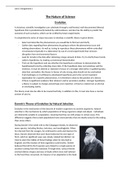Unit 5 Assignment 1
The Nature of Science
Evolution
A victorious scientific investigation can culminate through a well-tested, well-documented (theory)
hypothesis that is predominantly backed by valid evidence, and also has the ability to predict the
outcome of such scenarios, which can be verified by future experiments.
A comprehensive series of steps necessary to develop a scientific theory is given below:
Select and describe the phenomenon you would like to find out and clarify
Gather data regarding these phenomena by going to where the phenomena occur and
making observations. As well as, trying to reproduce these phenomena within controlled
circumstances (typically in a laboratory) by use of a test (experiment) that removes
disruption from environmental factors
Look for trends in the data after obtaining a large amount of data. Try to clarify these trends,
called a hypothesis, by making a provisional interpretation
Trial out the hypothesis and see whether the hypothesis continues to demonstrate the
hypothesised trend by collecting more data. If the hypothesis does not somehow suit the
evidence, it must be altered or rejected in favour of a stronger alternative. In gathering data,
data that contradicts the theory in favour of only strong data should not be overlooked
If all challenges on it withstand a developed hypothesis and is the current standard
explanation for a specific phenomenon, it is therefore raised to the position of a theory
If there is significant evidence that refutes it and/or promotes another, stronger hypothesis,
a theory is subject to change and perhaps even rejection. A theory is indeed not an eternal
or everlasting reality.
The theory must also be able to be researched fully, in addition to this, it must also have a concise
answer of yes/no.
Darwin’s Theory of Evolution by Natural Selection
Evolution is the mechanism of the descent of modern organisms via ancient organisms. Natural
selection is the mechanism by which populations of living organisms adapt and adjust. Individuals
are inherently variable in a population, meaning that they are still unique in certain ways. This
difference suggests that certain populations have characteristics that are ideally suited to the setting
than some others.
During Darwin’s five-week visit to the Galapagos Islands, he observed
many species, including finches, tortoises, and mockingbirds. When
he returned from his voyages, he continued to work and improve his
ideas. Darwin observed that each island endorsed its own type of
finch, which in significant ways was closely related but distinct. He
tried to solve the riddles of these findings when he returned to
England, and the mystery of how organisms could evolve. Darwin
believed that all the finch species were linked to a single species of
ancestor coming from the mainland. Through time, various finches
evolved distinct shapes and sizes of beaks which were well tailored
to the food they consumed. An instance of an adaptation is the beak





